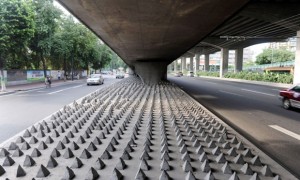“Defensive architecture” has been happening for decades in Southern California (and probably in many other locations), but re skaters.
This recent article reprinted in part below is a terribly brutal read about a similar idea, though specifically targeting homeless folks around the globe. How long before we see this in US cities… or do we already?
“Anti-homeless spikes: ‘Sleeping rough opened my eyes to the city’s barbed cruelty’” – via The Guardian (2/18/15, here).
The spikes installed outside Selfridges in Manchester are the latest front in the spread of ‘defensive architecture.’ Is such open hostility towards the destitute making all our lives uglier?
More than 100 homeless people are “living” in the terminals of Heathrow airport this winter, according to official figures – a new and shameful record. Crisis and the Joseph Rowntree Foundation have warned that homelessness in London is rising significantly faster than the nationwide average, and faster than official estimates. And yet, we don’t see as many people sleeping rough as in previous economic downturns. Have our cities become better at hiding poverty, or have we become more adept at not seeing it?
Last year, there was great public outcry against the use of “anti-homeless” spikes outside a London residential complex, not far from where I live. Social media was set momentarily ablaze with indignation, a petition was signed, a sleep-in protest undertaken, Boris Johnson was incensed and within a few days they were removed. This week, however, it emerged that Selfridges had installed metal spikes outside one of its Manchester stores – apparently to “reduce litter and smoking … following customer complaints”. The phenomenon of “defensive” or “disciplinary” architecture, as it is known, remains pervasive.
From ubiquitous protrusions on window ledges to bus-shelter seats that pivot forward, from water sprinklers and loud muzak to hard tubular rests, from metal park benches with solid dividers to forests of pointed cement bollards under bridges, urban spaces are aggressively rejecting soft, human bodies.
We see these measures all the time within our urban environments, whether in London or Tokyo, but we fail to process their true intent. I hardly noticed them before I became homeless in 2009. An economic crisis, a death in the family, a sudden breakup and an even more sudden breakdown were all it took to go from a six-figure income to sleeping rough in the space of a year. It was only then that I started scanning my surroundings with the distinct purpose of finding shelter and the city’s barbed cruelty became clear.
Continued… (here)
What do you think?
(pictured: example of anti-homeless spikes in China, from source here)
* * *
Got a sociology question? Need some social justice informed life advice? Contact Dr. Chauntelle right here.
